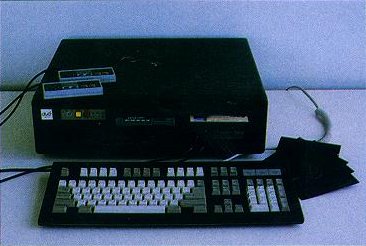 Probably the most obscure piece of NES hardware announced, the Duo FC series was announced in early 1990 to a very lukewarm response. The video game magazines of the time curiously ignored it, and only one or two computer magazines bothered to mention it. The picture above comes from a 1990 issue of PC Games magazine, and they had the following to say about it...
A Nintendo machine in the playroom or family room, a personal computer in the den or office - that's the way most of us separate single-purpose cartridge- based entertainment machines and multipurpose MS-DOS computers, which boast compatibility with thousands of software products, from spreadsheets and word processors to flight simulators and golf games. Now, however, you can have the best of both worlds. Not only can you have the two systems in the same room, you can have them in the same case. The Duo FC and Duo FC Plus are 8088- and 80286-based machines, respectively, that also contain a Nintendo engine. So you can go from Lotus 1-2-3 to Super Mario Brothers at the flip of a switch. Leigh Rothschild, president of Duo Computers, calls the FC and FC Plus machines "the ultimate family computers." As are Nintendo machines, the FC computers are designed to work with regular television sets. That's right - real VGA graphics with 256 colors right on your living-room TV. "I believe the Duo represents a technological breakthrough that will get computers out of the office and into the family rooms," Rothschild adds. Rothschild says he expects the Duo computers to ship on September 1 [1990] and that outlets for the machines should include mass-market retail stores, software stores, and some mail-order companies. At press time, the systems hadn't received approval from the FCC; Rothschild says he foresees no problems, however. More important than FCC approval, though, may be Nintendo approval. The monopoly-minded giant isn't known for an altruistic attitude toward free enterprise; the company could doubtless cause trouble for a relatively small operation such as Duo Computer. Rothschild says he has had "on-going communications with Nintendo," however, and calls the conversations "very pleasant." Because Duo Computers buys Nintendo parts from Nintendo, Rothschild says he doesn't think the talks will turn nasty. "Our situation is different from a company like Tengen - where every sale takes money out of Nintendo's pocket. With Duo, in fact, every sale puts money in Nintendo's pocket," he explains. Rothschild adds that he doesn't expect any supply problem and is "looking forward to complete cooperation with Nintendo." In addition to Nintendo hardware, both the FC and the FC Plus sport serial, parallel, and game ports, plus a VGA graphics card. (The machines also support EGA and CGA graphics formats.) The FC has 640k of random-access memory (RAM) and a built-in 360k 5.25 inch disk drive. The Plus comes with 1 megabyte of RAM, a 1.2 megabyte 5.25 inch disk drive, an AdLib music card, a 20-megabyte hard drive for extra memory and storage, and an optional 80287 math coprocessor. The Duo FC costs $999 and comes bundled with $90 worth of MS-DOS games. The FC Plus is priced at $1895 and comes with more than $400 worth of software. Both machines include MS-DOS 4.1. Rothschild's statements in this article are very odd, considering that the Duo FC is not mentioned at all in any Nintendo literature of the time, and considering that Nintendo was considering building its own computer network in a style similar to Prodigy at the time and could not have wanted a computer like this horning in on their revenue. Whether Rothschild was pulling his statements out of nowhere is unknown, but given that Duo Computer was born and died so obscurely, I doubt that he was telling the entire story. Still -- wouldn't it have been cool? 286 computers with Sega Genesis hardware inside of them were released by Amstrad in Europe about five years ago, so the idea certainly isn't farfetched. I imagine, however, that the Duo FC series died in the prototype form it was shown in due to legal wrangling with Nintendo. It was neither the first nor last loss to consumers due to Nintendo's strangle hold on the video game market at the time. Back.... |